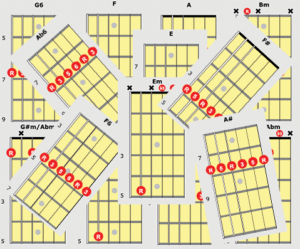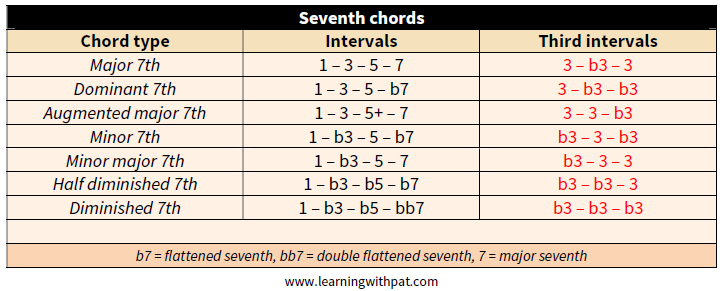
In this article, i would like to explain you one of my methods to find straight bar chords on a steel guitar instrument in any tuning.
This would not include chord inversions (chord with a bass note other than the root) but it’s a good starting point (i will do another one about chord inversions at some point).
The first thing you need to understand is how we build chords.
In tertian harmony, chords are built by stacking thirds, either major or minor thirds (a major third, a.k.a. “3” = 2 whole steps or 4 half steps, a minor third or flattened third a.k.a. “b3” = 1.5 whole steps or 3 half steps).
Let’s start with 3-note chords, also known as triads.
By stacking thirds, that means we have four different possible triads:

Let’s do the same with 4-note chords, also known as 7th chords.
There are now 7 possible permutations of major and minor thirds (the eighth one cycles back to the root thus is the same as the augmented triad), which gives the following chords:

This is probably a lot to absorb at this point so i would recommend to first understand how this works rather than learning everything by heart (although it’s a good idea to know at least the interval layout of triads as well as major, minor and dominant 7th chords 😉 ).
Using those charts as a guide, the next step is to analyze your instrument’s tuning to find out the different third invervals that could make chords.
Let’s try that with the common dobro tuning, GBDGBD.
This tuning gives us the following intervals from the thickest to the thinnest string:

So of course we get a major triad by strumming all 6 strings but if we take a closer look at the intervals in each group of 2 adjacent strings, we get:

Now you can see this minor third interval between both strings 5 & 4 and strings 2 & 1 so you can get instant minor chords by picking the notes of either of those string groups!
Let’s also take a closer look at this “3 – b3” group between either strings 6, 5 & 4 or 3, 2 & 1.
Using the two chord charts above, this gives us several chords possibilities:
- “3 – b3” makes a major triad
- “3 – b3” is part of a minor 7th chord so you could get a minor 7th chord without its root (which is perfect in a band situation where you don’t need to play all the notes of a chord)
- “3 – b3” also makes an augmented major 7th chord without the root (although you will probably not use this one as much as the more “common” ones except if you want to tackle some jazz 😉 ).
Now, let’s do the same thing with a C6 tuning (CEGACE).
This tuning gives us the following intervals from the thickest to the thinnest string:

Once again, we get an obvious major chord straightaway by playing the bottom 3 strings (or all 6 strings omitting the 3rd), but if we look at the intervals in each group of 2 adjacent strings, we get:

So like a GBDGBD dobro tuning, we’ve got this “3 – b3” group between strings 6, 5 & 4 which, as a reminder, can be used as:
- a major triad
- a minor 7th chord without the root
- an augmented major 7th chord without the root
But we’ve also got a “b3 -3” group between strings 3, 2 & 1 which opens up several chords possibilities:
- a minor triad
- a major 7th chord without the root
- a half diminished 7th chord without the root
You could also use this minor third interval between strings 5 & 4 to get a different minor chord than the one on strings 3, 2 & 1.
So lots of possibilities as you can see and we’ve only scratched the surface: we could also look at intervals between non-adjacent strings, chord inversions, extended chords…
Now, there’s one last trick i want to share with you.
One thing you might notice with this approach of finding chords is that although you can easily get major or minor shapes, you’d sometimes want full chords or maybe even more shapes.
This is where open strings come into play.
By using open strings, not only can you get full chords but also chords you would not be able to get otherwise!
For example, if we get back to our GBDGBD tuning example:
- You can get full minor chords (1, b3, 5) by using either the open 3rd, 2nd or 1st string as the fifth of the chord
- You can get new minor chord shapes by using either the open 3rd, 2nd or 1st string as the minor third of the chord***
So this brings out a whole new world of possibilities BUT you will also quickly find out that this does not mean every chord shape you’ll find will sound good… it will just depend on the situation: some chord shapes will sound good when you play them in a solo situation while others will sound better when used in a band situation with other instruments.
There are no rules there but the more shapes you know (or at least understand how to build), the more possibilities you’ll have when it comes to writing, arranging or improvising.
Before finishing, i would like to give you a little challenge: could you apply what we just did with an open D tuning?
Try to see what you can come up with and then have a look at my open D minor chords series where we explore minor chord shapes in open D tuning 🙂
Have fun!
***learn more about minor chord shapes in GBDGBD tuning with my intermediate minor dobro chords series!
Nice information.